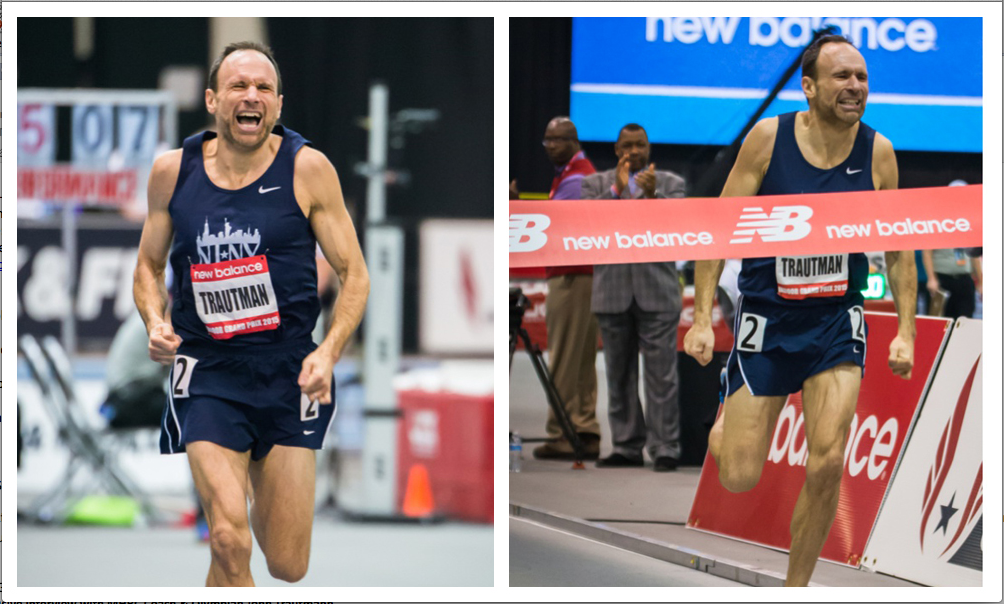Olympian John Trautmann joined the MHRC coaching staff this month. John not only competed in the 1992 Olympics, but he is ALSO the current WORLD RECORD HOLDER in the Master’s Mile. Lucky you can run with world champion Coach John at the east river track every Thursday night. We’re thrilled to introduce you to John and share his story here in this exclusive HIGHwire interview. What’s it like chasing such a lofty goal later in life? How did it feel to break running legend Steve Prefontaine’s high school 3,000-meter record? How does one get back in the racing mindset?
Did you ever think that you would race again after 1992 Olympics? Or did you think you had hung up your spikes for good once you started working?
- My exodus from competitive running after the 1992 Olympics wasn't something that I had planned. When I graduated from Georgetown in 1991, I signed a contract with Adidas to compete through 1996. Unfortunately an injury that I sustained in 1992 (hallux rigidus) essentially ended my career. I had different surgeries on my toe in 1993 and 1995 but neither helped and I officially “retired” a month before the Olympic trials in 1996. At this point, no, I did not see myself racing again.
What was it like breaking Steve Prefontaine's 3,000-meter high school record? How did that experience compare with becoming the world record holder in the Master's Mile? Both are pretty amazing!
- Thanks! I’m embarrassed to say, that being a stupid high school kid in 1986 I didn’t really know who Pre was until a few days before I attempted to break his record. Pre died in 1975 and I started running in the very early ‘80s. Remember this was back before the internet, and I didn’t really read any track history books. My father and high school coach told me a bit about him a few days before I broke his record, but I didn’t really appreciate the significance of it until much later. That being said, I was extremely happy and excited for the future after breaking his high school record. My masters record, on the other hand, felt more like satisfying a need for vindication.
So many stories focus on younger athletes just stepping into the spotlight, but what is it like chasing such a large goal a bit later in life? How does it affect training and your lifestyle?
- It was very exciting. When I first started pursuing the record I was working as a trader on Wall Street, so I was up before 5am every morning for my first training session and then would leave to work out again right after work at 5:30pm. Most of the guys I worked with knew I was chasing the record and would ask for updates all the time. They understood if I couldn’t go out after work or if I had to meet people after a training session for a work dinner. Other than training and going to work I didn’t do much else, I was just too tired. A few months before I set the record the company I worked for shut down our department. I had mixed feelings about it, but the free time allowed me to turn my training up a notch and to get more rest which was a big part of getting the record.
You've been running for so many years now as well as training at a very elite level. How do you keep your body healthy and able to handle such high intensity?
- I feel that the biggest reason that I am still able to train at such a high level is that I take long breaks from high intensity training blocks. After I broke the record, I actually didn’t run at all for 3 months. I don’t recommend that, but I do think it’s a good idea to turn the dial down for a while every year. Also I have found that the older I get, the more important nutrition has become. During some of my hardest training last year I was running 100 miles a week, but still had to keep a close eye on what I was eating or I would gain weight. That is much different than it was 25 years ago.
What advice do you have for runners just getting into the sport a bit later in life?
- I think the most important aspects to training are patience and consistency. Whether you decide you are going to run 3 days a week or 5, it is important that you give it time and continue to work. It takes a while for adaptation to occur, but eventually it will. Also you need to start off with small achievable goals. When I first started my comeback after gaining weight one of my first goals was to break 6 minutes in the mile. Once I achieved that, I made one that was a little harder. A few years later I had worked it down to a world record. The point is that each goal I set I had a decent chance of achieving and the excitement of achieving that goal motivated me to train for the next.
What’s next on your race calendar?
- Not sure what I will do next. I think once I turn 50 in a couple years I will take a shot at a few age group records, however until then I will probably just do some fun road races but keep the intensity pretty low.
I know you first started running again to lose weight. Did you ever think that start would take you back to the track and back to serious competition?
- Originally, I really didn’t think about competing again, just losing weight. But my college coach, Frank Gagliano, moved to the area back in 2009 and I started meeting him to do workouts on the track once a week just for fun. “Gags” is an unbelievable motivator and not long after I decided that I wanted to enter some races and have some time oriented goals. As I mentioned before, I set small achievable goals and 6 years later the last one became setting a world record.
How did you get back into the racing mindset after being away from competition for so long?
For me the racing mentality boils down to how much pain you’re willing to endure. When you work hard in training you are willing to endure more pain in racing because you feel as if you “deserve” to run fast. There comes a point in every race where you have to decide whether you are going to push through the pain or back off. The more I train and the more I race, the better I am at pushing through that point.
*Photo Credit: Joe Navas

